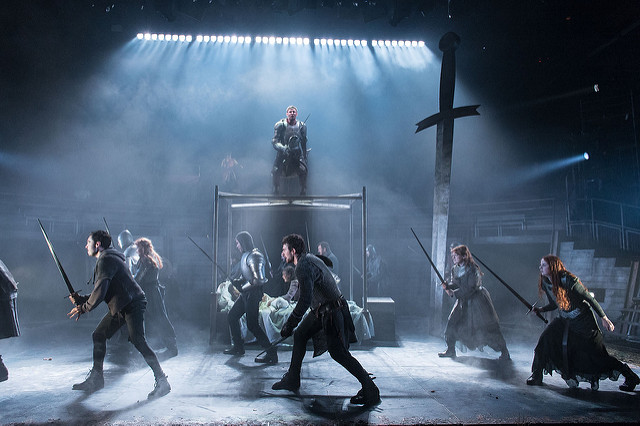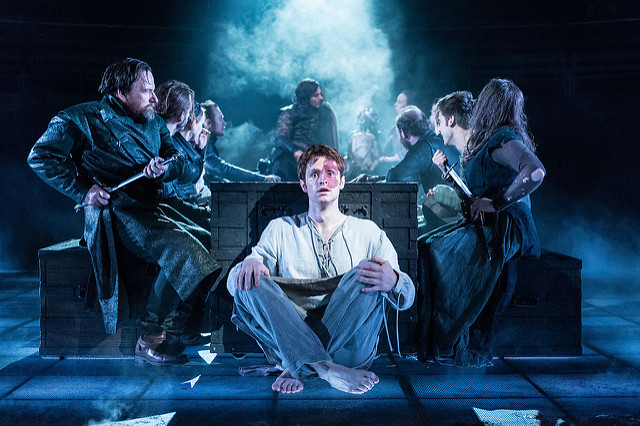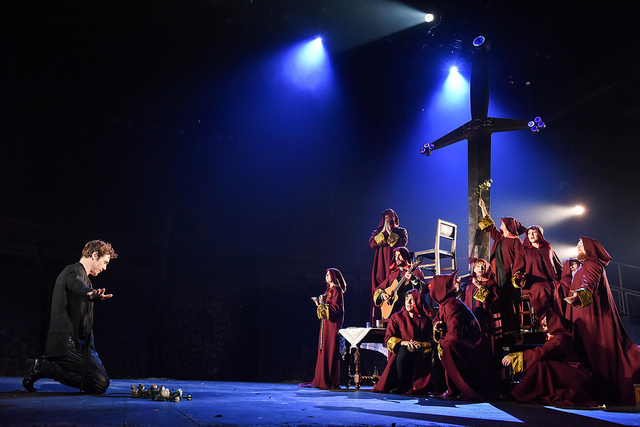This was the long-awaited return of Scottish National Theatre's 2014 incredible tour-de-force telling the story of the first three King James' of Scotland. Eagerly anticipated and grateful for their return and my chance to see these plays, I spent a whole day at Salford's Lowry Theatre to experience the magic for myself.
Despite being three individual plays which could be viewed separately and do stand alone, they are inextricably linked in so many ways, not least that they were all written by the same playwright, Rona Munro, and were intended as a trilogy. The three plays tell the story of Scottish royalty between 1421 and 1488; and although many of the facts have been manipulated for dramatic effect, they still serve as a good 'Bluff Your Way In History' guide to the Scottish Medieval period.
It would be a little pointless to try and write about these three plays separately. The one follows the other as surely as night follows day. Further, they all use the same set, they all use the same cast of actors, and all have the same director, Laurie Sansom, and creative team.
Munro has brought life and sound to a period of Scottish history which is scantly documented and full of legend. Tragic-heroic in their concept, grandiose in their design, but homely and familiar too. They are written in modern idiom, and yet feel old. They have that declamatory style of Shakespeare but without the archaic language and hard iambic pentameter. But most of all they have woven within all the warring, feuding, murdering and bloodlust, much humour, fun and homeliness too.
It's a long and hard day, starting at 11:00 am in the morning and going through until 10:15pm in the evening with only an hour and a half between each of the plays. This could certainly be classed as 'hardcore'. But think not of the audience, think of the actors performing this. The sheer energy and mental strain needed for such a marathon is astounding. Anyone who has ever been on a stage or has any knowledge of what it takes to take on a role will understand that this was no small undertaking.
The acting throughout the trilogy was magnificent. The ensemble work was excellently conceived and performed. (With great sound effects too). Most of all though I loved the individual character traits of the three successive kings, the fact that they all did look somehow similar and all did have things in their characters in common with each other. This was superbly thought through and brought to light.
James I - The Key Will Keep The Lock
In James I, for me the best of the three, we start the play with the end of the Battle of Bauge and the return to Scotland of James after his imprisonment in London. 
It is a time of Scottish reformation, and this build from distrust from the Scots to earning respect from them was wonderfully played. Balanced with this the fact that he had been married to Joan, an English noblewoman and relative of Henry IV, whose youth, eagerness, and, at first, neurotic nature brought a lovely dynamic to the play, was really well placed. Although, as all great women in history have done, she became the rudder and steered the King in the right directions. James I being played with unnerving sincerity here by Steven Miller, with his rock, Queen Joan, Rosemary Boyle, making her professional stage debut - and my what a debut this was!
Of special note in the first play was Peter Forbes' portrayal of Balvenie. This was an excellently well-measured and assured performance, delightful to watch. Also, I enjoyed both Meg (Sally Reid) and Murdac Stewart (John Stahl).
James II - Day Of The Innocents
In the second play, James II, the play starts with the King hiding in a box, he is 6 years old. This is no reflection on the writing, the writing was superb, but the directorial choice of having the adult actors play the young boys for me wasn't so convincing. I totally understood, and totally followed, but nevertheless would have preferred to have seen children playing the children's parts. This play is much darker, and much more metaphor heavy. James II is mad, mentally unstable; having witnessed so many atrocities to his own kith and kin at such an early age who wouldn't be? And this habit of returning to the comfort of his box stays with him throughout his life, and puts a strain on his marriage. His nightmares stay with him and the ghosts come back to haunt him. If James I was Hamlet, then this is certainly MacBeth. In this play the King was played with deftness and aplomb by Andrew Rothney, and his all-suffering but understanding and dutiful wife Rosemary Boyle.
Other roles to impress me here were Blythe Duff as Isabella Stewart, and although she had a major role in James I, it was only here, whilst manacled to her prison cell wall she really made her mark. As Balvenie (Peter Forbes) contracts the plague and lies dying in bed, still desperate to marry his family to Galloway in order to have complete control of all the border lands, his son, William, played by Andrew Still really came into his own. Again special mentions to two other actors. Once again, John Stahl, this time playing the manipulative and greedy Livingston, Earl Of Stirling Castle. A fine actor. His 'rival', Crichton, Earl Of Edinburgh Castle, was played with equal skill by David Mara.
However this second play was home to these plays' weirdest direction choice; a bull's head being brought in for the table and then being used as the head of the man. I'll say no more, as I understood the significance of it, and it will spoil the story for those that haven't yet seen it, but again, it's always a matter of subjectivity, for me, it really did not work.
James III - The True Mirror
Moving on to the third play, (a very camp and biting comedy with some tragedy thrown in!?), and this starts with the King already an adult with his wife and baby, and takes us through to his death, and the coronation of his son as James IV. The King here was depicted as bisexual and an aesthetic hedonist. Perhaps he was. We do certainly know that he rarely left his castle, and devoted much of his time to poetry, music and art; preferring these to the duties of government and ruling. As fine as Matthew Pigeon's performance as King James was (and indeed it was fine - and totally different from his sterling portrayal of Henry IV in the first James play - taking one of his lines extremely literally, "If you can think a thing, you can do it".), it was overshadowed by some very odd design choices. {See below}, and some rather splendid acting from his Queen, played by Malin Crepin, the only member of the company to perform in only one of the plays. However, her Danish accent was spot on - mind you, being Swedish, and this being her UK theatre debut, that shouldn't be surprising - and her stalwart performance exemplary.
Again, there were some noteworthy performances going on around the two protagonists. Blythe Duff once again impressed, this time as The King's aunt, Anabella, along with John, the Head of The Privy Council, (Daniel Cahill), and the laundress Daisy (Fiona Wood).
The set by Jon Bausor was excellent, and imagery-full. Designed as a giant bear pit or arena, where the audience sits above and around the action watching the spectacle unfold below them was genius. The stage's acting space had been vastly reduced to accommodate this. A metal grid on the floor formed the acting area with high wooden walls in a semi-circle, although giving the impression that this should continue round and enclose them. Steps either side lead up to a gallery where there was onstage seating on two sides of this semi-circle. Those seated here also became silent and unwitting members of the Scottish Parliament when it was in session! A platform top centre was the focal point, and used variously as the throne room, an ante-chamber, and a prison cell, among others. Below this a large opening with doors, drawbridge and steps, depending on the setting. Add to this an omnipresent and extremely large claymore stuck, point downwards, into the steel flooring; a more potent and allegorical symbol could not have been found. The set was constant - we were the spectators, and they were the medieval gladiators fighting it out to the death. The majority of the set remained throughout the three plays, with some rather subtle but effective changes for each. The second play having the wooden slats destroyed atop the dais, and the wooden entrances either side made into holes. And the third play had flowers, many flowers.
Add to this some imaginative and clever lighting - steels, adding cold and damp to this amphitheatre of treachery, and the atmosphere is complete. I loved the lighting of the sword, and the backlights on the supports at the rear of the onstage audience. Actually I really liked the lighting design, by Philip Gladwell, full stop.
If we are to allow a playwright to meddle with historical accuracy, {if it's good enough for Shakespeare......}, then should we also allow a costume designer, a composer / musician, and a director the same freedom? That is an extremely good question, and one which, no doubt, could be debated upon ad infinitum. I guess, at the end of the day, it all comes down to a matter of personal choice.
I will therefore overlook the historically inaccurate costumes of the first two plays. At least they did manage to look vaguely medieval. (Except the kilt! that is a very modern aberration), and also discount the very modern bagpipes too. (Bagpipes of varying styles have been used for centuries, but the modern design has been around, like the modern kilt, since the Victorian era.) I am even prepared to overlook the historical fact that the sword of preference with the Scots at that time was indeed the claymore (how could we forget this with the gigantic one stuck there on the set for all to see, which even drips blood in the first play and spits fire in the second!), yet, for not one of the battles, not one of the many armies of men depicted used such a heavy, two-handed sword.
However, what jarred with me, and jarred beyond redemption was the decision to costume the third play in modern dress. We have just seen a costume drama unfold before our eyes, and we have bought into this pseudo-realistic Medieval clothing, just like we would when watching a Hollywood film; however, after two thirds of the film, we suddenly find that all the actors are now wearing 20th century clothes but still acting in the same setting and using Medieval props and set. Even the songs and dances are modern. A Twist and, 'Don't You Want Me Baby' start this play! And to see the King in a gold blouse and tight pants kiss a semi-naked man in bondage gear was certainly out of kilter with the previous two plays! If the first two plays were Hamlet and MacBeth, then this must surely have been The Comedy Of Errors! I was very surprised to learn then that the costume designer was the same for all three plays and was also the same person who designed the set, Jon Bausor.
The directing, by Laurie Sansom, was consistent throughout. Majority of the action was done in real time and played naturalistically. Moments of heightened tension, especially battle scenes were done much more stylistically and slowed down. It was a formula that worked well. The work on character and character development was beyond reproach, and the balance between tragedy and humour, excellent. Even in the third play, which was less successful simply due to the strange design and music choices, the style and acting was constant and sincere.
There are some excellent lines in these plays, and I wouldn't be at all surprised to see them soon on school exam syllabuses; however my favourite line ends the first play, and states simply, "The wheel will turn. The wheel always turns. The wheel will turn round again."
Reviewer: Mark Dee
Reviewed: 23rd April 2016
(The day of Shakespeare's birth, death, and the English holiday of St. George.)
Pictures: Manuel Harian & Robert Day

